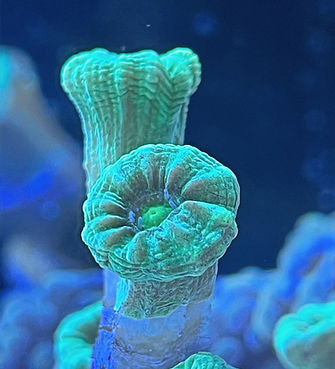
Kryptonite candy cane
Candy cane coral
Origin and Description:
Candy Cane Coral is a popular species of LPS (Large Polyp Stony) coral that belongs to the genus Caulastrea. It is native to the Indo-Pacific region, including Fiji, Indonesia, and Australia.
It gets its name from its candy cane-like appearance, with alternating bright-colored polyps on a hard coral skeleton.
- Candy Cane Corals come in various colors, including green, red, purple, and blue.
Tank Setup:
Tank Size: Candy Cane Coral can be kept in medium-sized aquariums, with a minimum tank size of 30 gallons for a small colony.
Substrate: Provide a sandy substrate or live rock for the coral to attach and grow on. Candy Cane Coral can also be glued or mounted on rock or coral frag plugs.
Water Flow: Moderate water flow is ideal for Candy Cane Coral. Ensure good circulation to provide nutrients and prevent detritus from settling on the coral.
Lighting: Candy Cane Coral requires moderate to high-intensity lighting. LED lights or T5 fluorescent lights with a spectrum that includes blue and white colors are commonly used. Adjust the lighting intensity based on the specific needs of your coral.
Water Parameters:
Temperature: Maintain a stable temperature between 75°F to 80°F (24°C to 27°C).
Salinity: Keep salinity levels between 1.023 and 1.025.
pH: Maintain a pH level between 8.1 and 8.4.
Alkalinity, Calcium, and Magnesium: Regularly test and maintain appropriate levels for the healthy growth of the coral. These parameters are crucial for the formation of the coral's calcium carbonate skeleton.
Nitrate and Phosphate: Keep nitrate levels below 5 ppm and phosphate levels below 0.03 ppm to prevent excessive algae growth, which can harm Candy Cane Coral.
Feeding:
Candy Cane Coral is primarily photosynthetic and gains a significant portion of its nutrition from the symbiotic algae called zooxanthellae present in its tissues. These algae use light to perform photosynthesis and provide the coral with energy.
However, Candy Cane Coral can also capture small food particles from the water column.


